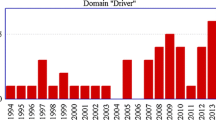Abstract
In this paper recent research into operating an intelligent mobile vehicle (denoted MV) is presented. A complex control procedure, having a two-input and twooutput fuzzy controller as kernel, is used. The inputs to the fuzzy controller are provided by a charge-coupled device (CCD) camera which transforms information on special objects by using an image processor. The MV is capable of tracking objects, searching for objects in space and recognizing a traffic signal. Results of laboratory testing are presented.
Similar content being viewed by others
References
Linkens DA, Nyongesa HO (1996). Learning system in intelligent control: an appraisal of fuzzy, neural and genetic algorithm control applications. IEE Proc Control Theory Appl 143(4):367–386
Laumand JP, Jacobs PE (1994) A motion planner for nonholonomic mobile robots. IEEE Trans Robotics Autom 10(5):577–593
Enab YM (1996) Intelligent controller design for the ship steering problem. IEE Proc Control Theory Appl 143(1):17–24
Fleury S (1995) Primitives for smoothing mobile robot trajectories. IEEE Trans Robotics Autom 11(3):441–448
Yoshizawa K, Hashimoto H (1996) Path tracking control of mobile robots using a quadratic curve. Proceedings of the 1996 IEEE Intelligent Vehicles, Tokyo, Japan, Sept. 19–20, 1996, pp 58–63
Sugisaka M, Wang X (1996) The development of a practical control method for an intelligent mobile vehicle. In: Sugisaka M (ed) Proceedings of the International Symposium on Artificial Life and Robotics (AROB 1), Beppu, Oita, Japan, Feb. 18–20, 1996, pp 234–237
Gorinevsky D, Kapitanovsky A, Goldenberg A (1996) Neural network architecture for trajectory generation and control of automated car parking. IEEE Trans Control Syst Technol 4(1):50–56.
Madan M, Rommohan K (1990) Advances in fuzzy set theory and applications. North-Holland, New York, pp 100–130
Sugeno M (1989) Fuzzy control (in Japanese). Nikkankougyo shinbunsha, Tokyo, pp 74–84
Anzai Y (1992) Pattern recognition and machine learning. Academic, San Diego, pp 134–139
Sugisaka M (1997) Development of a mobile vehicle (in Japanese). Kikainokenkyu 49(6):625–633
Sugisaka M, Hara M, Tonoya N, Ike Y, Kim SW, Lee JJ (1994) Running test of a mobile vehicle. Proceedings of the Asian Control Conference, Tokyo, Japan, July 27–30, 1994, pp 439–442
Author information
Authors and Affiliations
Corresponding author
About this article
Cite this article
Sugisaka, M., Wang, X. & Lee, JJ. Control strategy for an intelligent mobile vehicle. Artificial Life and Robotics 1, 185–190 (1997). https://doi.org/10.1007/BF02471138
Received:
Accepted:
Issue Date:
DOI: https://doi.org/10.1007/BF02471138




